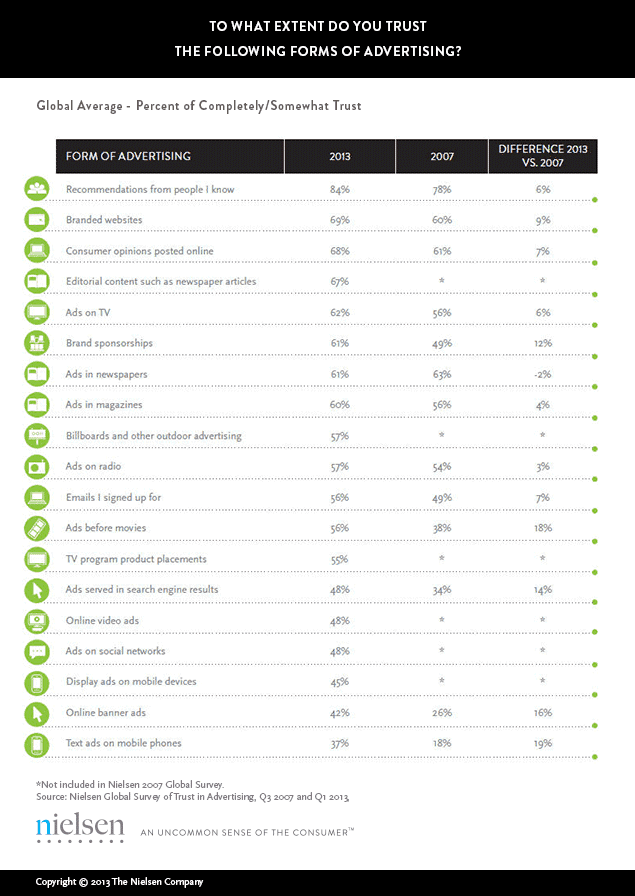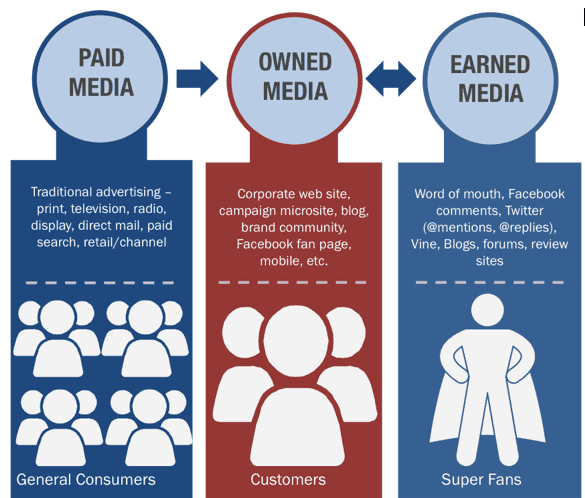The Four Flavors of Content Marketing: Paid, Earned, Owned and Converged Media
Almost ready to launch your 2014 content marketing plan? Step back away from the keyboard. Consider what you’ve planned through three lenses: Paid, Earned and Owned Media. A few minutes review might help you squeeze out some additional results.
Defining Paid, Earned and Owned Media
If you haven’t been introduced to these terms, don’t worry. Here are the most simple definitions of the three flavors of content marketing:
Paid Media: Advertising.
Owned Media: Company website, social media accounts, printed promotional pieces.
Earned Media: Articles about your company in magazines and newspapers, word of mouth or comments on social media.
An illustration of the three most common types of media: Paid, Owned and Earned. This example also places a value on which type of customers participate in each media. Customers engaged with earned media are judged as being most valuable.
Many marketers want to add a fourth kind: converged media.
What is converged media?
Converged media has become more prevalent as marketing platforms evolve. For example, it’s possible to refer to Facebook as converged media. If a company is advertising on Facebook (paid media), has their own page on Facebook (owned media) and is responding to comments and shares Facebook users have made about their brand or content (earned media), then for them, Facebook is converged media.
Another example of converged media would be if you publish a blog post on your website (owned media), tweet about it, and that tweet gets retweeted. The retweets are earned media, and so, in a sense, your blog post is now converged media.
Defining pieces of content as converged, earned, paid or owned media can get confusing fast. It can blur project scopes and make job descriptions vague. And, worst of all, after all the hair-splitting of what kind of media something is, there’s no increased results, and no productivity gained.
It’s best to not get too caught up in whether something is converged media or not. You’ll get better results if you just focus on the one kind of media that’s proven most effective.
Earned media is most effective
Of the four kinds of media, earned is the most effective. It’s also the only kind you can’t buy. It relies on outside media sources and customers to do the promotion for you, and that is exactly what it’s so valuable: Any earned media is a 3rd party saying your company or your campaign is worth talking about. That’s always going to carry more weight with people than an ad for your company or a post on your company blog.
Earned media is trusted media
So just how effective is earned media? Consider this chart from Neilson’s 2013 Global Trust report, which names word of month (another term for earned media) as the single most trustworthy marketing medium available. The chart shows 84% of people trust word of mouth. The next closest medium was branded websites, with 69% of people finding them trustworthy.

Earned media is not just trusted more. It also converts better – five times better. An article in AdAge reported earned media converts at a rate of 5%, compared to just 1% conversion rate from paid media.
Social media and earned media
Clearly, as social media grows and more people share more and more content, earned media is a growth industry. Combine the new opportunities for earned media with how well it converts, and you can see why so many marketers are intrigued.
Earned media even outperforms owned media, i.e. most content marketing. People may only consume owned media if
a) it’s useful
b) it’s entertaining
c) it’s needed
Beyond that, they don’t care. But if a friend tweets about a new phone, or a business partner can’t stop talking about a new app, it’s most likely your customer will take notice. They are as interested in the friend as they are in what the friend is saying.
Earned media comes at a price
While all this sounds great, it’s not the full story. Earned media takes work. You will, literally, have to earn it, and you’ll be competing with every other piece of information available online. That’s no small task. But if your content has just a few key elements, you might earn yourself a lot of exposure.
Earned media requires a story
If storytelling was gasoline, earned media would be a car. This applies both to social media shared stories, and to “brand journalism”, where publications like Forbes and Fast Company tell the stories of exceptional companies. Whether it’s a new way of doing business (like Zappos incredible customer service, or Warby Parker’s style) the companies winning the most earned media have the most powerful stories.
Take note: Storytelling and branding are sisters. If you’re having a hard time developing a story for your company or product, take a hard look at the brand – it may need some work itself.
Earned media requires distribution
Sure, word of mouth can happen even with the electricity off (but so can a Twitter campaign, as Oreo taught us earlier this year at the Superbowl), but often, the marketing campaign with a great distribution plan will win over a marketing campaign with a mediocre one.
In the last year we saw the term “content distribution” gain exposure as marketers realized content has to be great to get shared, but it also has to get found in the first place.
If you had to pick a great distribution plan versus a great story, a great distribution plan might win out. But if you can, get both the story and the distribution plan.
Another tip: Distribution can get a big boost if you use technology to make the sharing worth people’s effort. Ask yourself: What’s in it for them? Why should they share this content? Why would you share your content?
Earned media requires understanding your audience
If you want your customers to spread your message, you’ll need to know what they like to spread. We see this everywhere online. For example, visual content tends to beat out written content. So, if you want your content to be shared, make it visually appealing.
Is your audience more likely to love cats, or dogs, or muscle cars? Whatever the answer is, add the appropriate image on your content.
Rather than randomly testing what works (or spending hours using Facebook’s graph search), marketers can survey their customers to find out what matters to them. Surveys are not a perfect tool, but they can go a long way to getting you on the same page as your customers. Take what you learn and put it into the DNA of your content, and your shares will likely take off.
Hopefully, there’s a journalist somewhere in your audience, so you’ll get some press, too.

